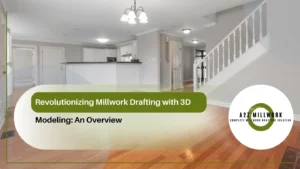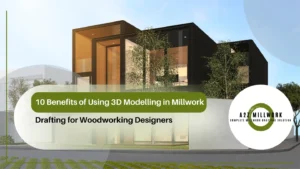Understanding the Differences Between Millwork and Wood Casework
As an emerging architect, establishing dependable contacts and contractors in the industry is crucial. Distinguishing between millwork and wood casework is essential for selecting the right supplier for your projects and providing informed advice to your clients.
Overview of Millwork And Wood Casework
Casework
In the woodworking industry, “casework” specifically refers to the construction of wood cases or boxes, such as built-in cabinets, bookcases, kitchen island drawers, cupboards, and other storage cabinetry. These items can be prefabricated and assembled onsite, like a pre-manufactured kitchen, or completely custom-made to fit unique measurements.
Millwork encompasses wood products fabricated in a mill, including doors, panels, moldings, and trims. These bespoke pieces are tailored to the client’s specifications and are often unique in dimensions, shapes, and materials. Although casework can be considered a type of millwork, the two have distinct characteristics.
Key Differences Between Millwork and Wood Casework
Wood casework is generally mass-produced based on standard measurements and designs, making it widely available and consistent in appearance. Millwork, conversely, is typically customized to client specifications, resulting in limited production runs and greater variation.
Production
Wood casework is generally mass-produced based on standard measurements and designs, making it widely available and consistent in appearance. Millwork, conversely, is typically customized to client specifications, resulting in limited production runs and greater variation.
Price
Mass-produced casework is generally more affordable, especially when sold as flat-pack or ready-to-assemble furniture. Customized millwork, however, is more expensive due to its bespoke nature and the need for professional installation.
Fit
Standardized casework may not always integrate seamlessly with a building’s design, whereas millwork can be tailored to fit precisely into any space, matching the aesthetic and functional requirements perfectly.
Installation Time
Millwork requires detailed measurements, technical drawings, and professional installation, leading to longer installation times. Casework, being prefabricated, typically involves quicker installation without the need for precise measurements.
Architectural Drawings
Complex millwork pieces depend heavily on detailed architectural shop drawings to ensure accurate production and installation. While some custom casework also requires detailed drawings, standard casework relies less on these precise plans.
Final State of the Product
Millwork is intended to be a permanent fixture, integrated seamlessly into the building. Casework, often modular, offers more flexibility for relocation or modification, making it a more temporary solution.
For a deeper understanding of wood casework and its standards, including the new ANSI/AWI 0641-2019 Standard, Read out comprehensive guide.






